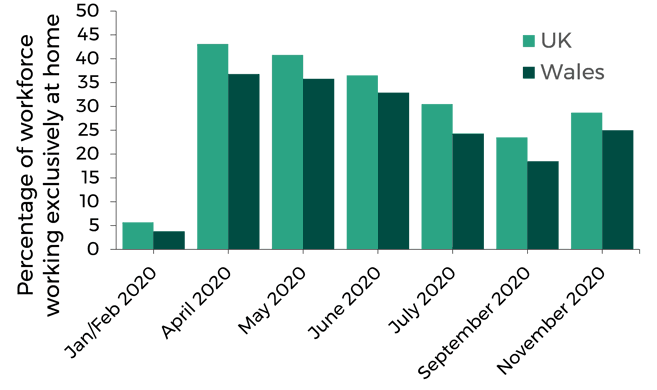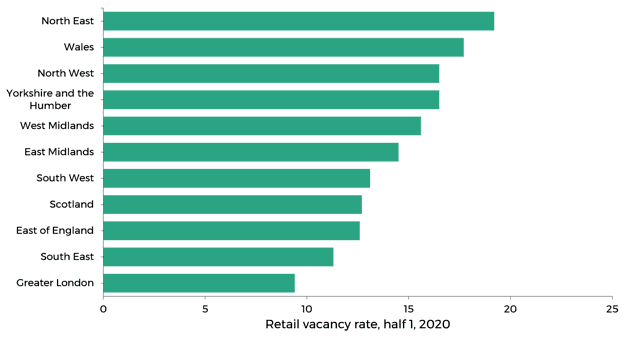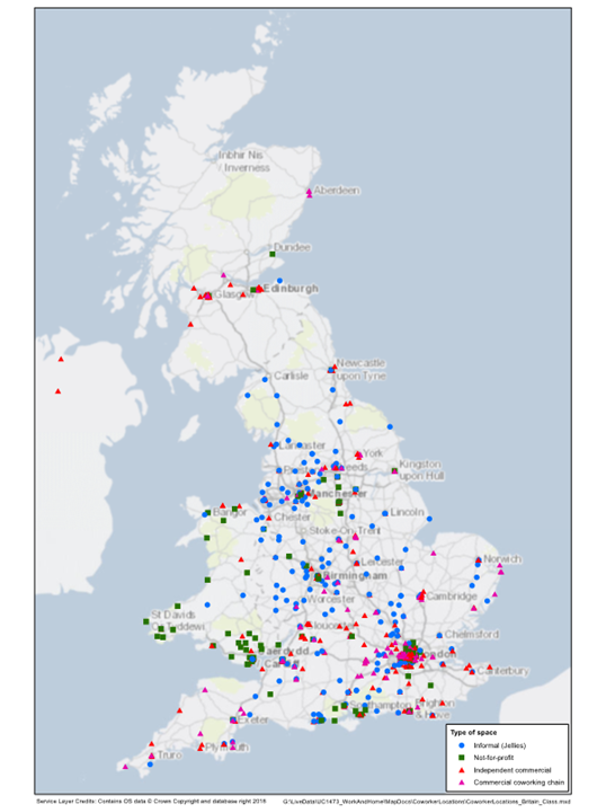Since the start of the coronavirus pandemic, many more of us have been working at home. Analysis from Professor Alan Felstead shows that the number of people in Wales working exclusively at home peaked at almost half a million in April 2020, and was just over 300,000 in November 2020.
In September 2020, the Welsh Government set out its ambition for 30% of the workforce to regularly work remotely, through a mixture of working from home and in remote working hubs close to home. The Senedd’s Economy, Infrastructure and Skills (EIS) Committee has been undertaking work on this topic, and on 17 March the Senedd will debate its report Remote Working: Implications for Wales.
What are the trends in working at home during the pandemic?
The percentage of the Welsh workforce working from home has increased considerably since the start of the pandemic. Work undertaken by Professor Felstead for the EIS Committee highlighted that just 4% of the Welsh workforce worked exclusively at home at the start of 2020, but that this rose to 37% in April 2020 and was at 25% in November 2020.

Source: Felstead, Outlining the contours of the ‘Great Homeworking Experiment’ and its implications for Wales
Research for the Committee led by Dr Darja Reuschke shows that during the pandemic the rise in those mainly working at home was slightly higher in rural areas than urban ones, in contrast to the UK.
Professor Felstead’s analysis also highlights that 56% of Welsh workers are unable to work at home, which is much higher than anywhere else in Great Britain – the next highest percentage was in the East Midlands, where 44% of workers were unable to work from home. This is due to the differences in sectors that people in Wales are employed in, with fewer people being employed in sectors such as banking and finance where there was a dramatic increase in homeworking. The research led by Dr Reuschke found that ability to work at home was highest in urban areas such as Cardiff, Swansea and Newport, and lowest in industrial areas such as the Valleys.
Professor Felstead states that the recent rise in home working has “been disproportionately taken up by those with better quality jobs” that pay more, noting that more than 80% of those in ‘elementary’ occupations such as factory machine operators and labourers did not carry out any work at home during the first lockdown. Wales Trades Union Congress (TUC) has published analysis which found that 61% of ‘middle class’ workers want to work from home in the future compared to 33% of ‘working class’ households. The Committee recommended that the Welsh Government assess the socio-economic impact of its remote working policy, and how it will comply with the requirements of the Socio-Economic Duty, which will come into force on 31 March.
Academic and business witnesses suggested that the Welsh Government’s 30% ambition is achievable, although greater clarity is required on how the target is defined. The Confederation of British Industry (CBI) Wales told the Committee that whether the ambition can be achieved “depends how you cut the 30 per cent target”, while Professor Felstead stated that there is a need to “press Welsh Government to what it means by 30 per cent, because it's incredibly vague”. The Committee recommended that the Welsh Government should develop clear definitions of “remote working” and working “at or near to home” to enable precise measurement of progress in achieving the Welsh Government’s ambition, and to gather robust Wales-specific data.
What have been the impacts of increased working from home on the workforce?
Studies of employers and workers have shown that increased homeworking has had either a positive impact or no impact on workforce productivity. A UK-wide study by the CBI found that employers were twice as likely to say that remote working had a positive impact on their firm’s productivity as they were to say that it had a negative impact. Professor Felstead found that in September 2020 around 85% of workers reported that they got the same amount or more work done while working at home.
However, evidence received by the Committee from Wales and the rest of the UK, Finland and the Netherlands identifies a number of areas where challenges have emerged. The Federation of Small Businesses (FSB) Wales highlighted that many employees have been working longer hours, and that borders between home life and work have been removed. They also highlighted concerns around the impact of remote working on creativity and innovation. CBI Wales noted that workers in sectors such as banking had been as productive initially, but the difficulties of working alone in roles dealing with many distressed customers were impacting upon the productivity and mental health of some workers as time progressed.
Employment rights are not devolved to the Senedd, and the Committee expressed concern that this means the Welsh Government has fewer levers to protect remote workers’ rights, although it noted that the UK Government has committed to bring forward a UK-wide Employment Bill. Wales TUC called for the Welsh Government to explore using social partnership legislation to support employment rights, and to develop and monitor fair work measures in relation to remote work through the Economic Contract it has with businesses it financially supports. The Committee recommended that the Welsh Government set out how it intends to use its devolved levers to protect and promote the rights of those working remotely, and should also detail what it would want to see from UK-wide employment legislation in respect of remote workers’ rights.
Home working has had different impacts across different groups within the population. Legally Disabled? told the Committee that “evidence suggests increased availability of remote working could have widespread positive benefits for disabled people”. The Office for National Statistics found that at the start of the pandemic women spent much less time undertaking paid work than men when working at home, but spent more time on unpaid childcare and housework. However, evidence from Professor Abigail Marks and the TUC finds that many mothers have been required to combine full-time work with home schooling and housework – often working very early or very late in the day to make up their hours. Chwarae Teg said that supporting remote working as part of a wider strategy to implement agile work could help to address gender inequalities.
The Committee recommended that the Welsh Government should set out how it is mainstreaming equality in developing its remote working policy, and publish an integrated impact assessment as soon as possible.
How has increased working from home impacted upon high streets and urban centres?
High streets have been impacted considerably during the pandemic, with pre-existing issues facing the retail sector being exacerbated by a major transition to online shopping during the pandemic. This acceleration to online shopping was described last October by the Welsh Retail Consortium as “five years’ worth of transformation happening in the five-month period”. This is illustrated by data from the Local Data Company, which shows that shopping centres, high streets and retail parks all saw a decline in retail occupation during the first half of 2020. The retail vacancy rate for Wales in the first half of 2020 was 17.7%, higher than any other part of the UK except for North East England.

Source: Local Data Company, GB Retail and Leisure Market Analysis, H1, 2020
The Wales Centre for Public Policy considers that in the long-term, footfall may shift from urban centres to the suburbs, as people spend more time working at home or in their local area. They suggest that large town centres and urban centres are likely to be more affected than smaller towns, as larger companies that are more likely to encourage remote working are most likely to be concentrated in urban centres.
The Committee recommended that the Welsh Government should bring forward a retail strategy and plan to respond to remote working trends, and set a clear path for that sector.
However, there is optimism that town and city centres can be repurposed where this is needed. Town Square expressed their belief that we have a “massive opportunity to create liveable cities”, and IndyCube Wales noted that people congregate in urban centres because “they like the buzz, they like the experience, and it's about creating that offer again within the city centres and allowing people the flexibility to work closer to home”. Elements that could create that experience in a post-pandemic world include cultural experiences and more open green space.
What is co-working, and what are the Welsh Government’s plans to develop remote working hubs?
Research for the Committee led by Dr Darja Reuschke highlights that co-working has traditionally been “independent professionals working in shared, collaborative workspaces”, which allow them to meet like-minded people and to combat social isolation. In Wales, this involves much more not-for-profit and member co-operative co-working spaces than the rest of the UK, including in the Valleys and rural areas.

Source: Reuschke, Clifton and Long, Remote working – spatial implications in Wales
The Welsh Government has set out plans to explore developing a network of remote working hubs in towns and communities, and has announced a number of pilot projects. It is currently asking people to say where in Wales they would like to co-work, through a consultation using interactive maps. Wales TUC has also conducted analysis of future demand for co-working, this found that 17% of respondents would be likely to work from a co-working hub for at least one day a week. The Wales Centre for Public Policy highlighted that “there may be greater appetite for localised workspaces and hubs, but there is not currently evidence for this, and the need should be established and verified before any significant investment is made.” The Committee’s recommendations echoed this theme, calling for the Welsh Government to build a greater evidence base around co-working spaces.
The work led by Dr Reuschke identified Milan as an example of good practice in supporting co-working hubs, and working closer to home. Milan has identified spaces that could potentially be used for co-working; accredited suitable co-working spaces and provided co-funding to develop them; and developed a voucher scheme that provides workers with up to €1,500 to work in accredited spaces. The Committee has recommended that the Welsh Government set out its plans for providing financial and other support to the existing co-working hub network in Wales.
What does the future hold for remote working?
As the Committee’s report noted, home-schooling children, cats and dogs all made appearances during its evidence sessions, illustrating some of the difficulties of homeworking without the right conditions. “The widespread hope and expectation is that a healthier hybrid model of flexible working will emerge”. However there are a number of challenges that will need to be addressed to achieve this for those who can work remotely, while also considering the needs of those who can’t, or who would prefer to return to the workplace.
You can watch the debate on Senedd TV on 17 March.
Article by Gareth Thomas, Senedd Research, Welsh Parliament






